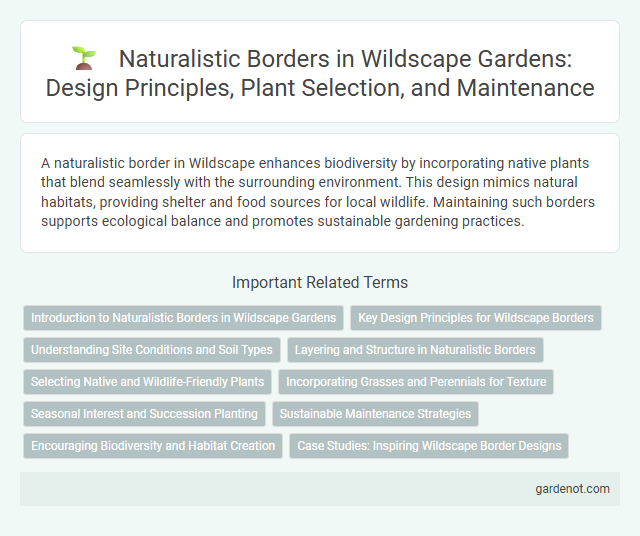A naturalistic border in Wildscape enhances biodiversity by incorporating native plants that blend seamlessly with the surrounding environment. This design mimics natural habitats, providing shelter and food sources for local wildlife. Maintaining such borders supports ecological balance and promotes sustainable gardening practices.
Introduction to Naturalistic Borders in Wildscape Gardens
Naturalistic borders in Wildscape gardens replicate native ecosystems by integrating indigenous plants, creating habitats that support local wildlife and promote biodiversity. These borders enhance ecological resilience by mimicking natural plant succession and providing food and shelter for pollinators, birds, and beneficial insects. Incorporating species such as native grasses, wildflowers, and shrubs fosters a sustainable environment while maintaining aesthetic appeal aligned with the Wildscape philosophy.
Key Design Principles for Wildscape Borders
Naturalistic borders in wildscape design emphasize native plant species to support local wildlife and biodiversity. Key design principles include layering plants by height to create habitat complexity, ensuring seasonal variation for continuous food sources, and incorporating structural elements like logs or rocks to provide shelter. Selecting drought-tolerant, pollinator-friendly plants enhances ecological resilience and visual appeal.
Understanding Site Conditions and Soil Types
Naturalistic borders thrive when tailored to specific site conditions, particularly soil types that influence plant selection and growth patterns. Loamy soils with good drainage support a diverse range of native species, enhancing ecological balance and habitat value in wildscape designs. Accurate assessment of soil texture, pH, and nutrient content ensures the border promotes sustainable plant health and resilience.
Layering and Structure in Naturalistic Borders
Naturalistic borders thrive on strategic layering and structural diversity, incorporating varying plant heights, textures, and colors to mimic natural ecosystems. This approach enhances biodiversity by providing multiple habitats for insects, birds, and small mammals, fostering ecological balance. Integrating native species with staggered bloom times ensures continuous visual interest and supports pollinator activity throughout the seasons.
Selecting Native and Wildlife-Friendly Plants
Creating a naturalistic border in a wildscape involves selecting native and wildlife-friendly plants that support local ecosystems and enhance biodiversity. Native species such as coneflowers, black-eyed Susans, and milkweed provide essential nectar sources for pollinators and habitat for birds and insects. Incorporating these plants promotes ecological balance, reduces maintenance, and fosters a thriving wildlife habitat.
Incorporating Grasses and Perennials for Texture
Incorporating grasses and perennials creates a naturalistic border that enhances texture and visual depth in a wildscape design. Species such as Miscanthus sinensis, Panicum virgatum, and Echinacea purpurea provide dynamic movement and seasonal interest while supporting local biodiversity. This approach fosters a resilient, low-maintenance landscape that mimics native habitats and attracts pollinators.
Seasonal Interest and Succession Planting
Naturalistic borders in wildscapes enhance biodiversity by incorporating seasonal interest through carefully selected native perennials and grasses that bloom in succession, ensuring year-round visual appeal and habitat support. Succession planting strategies optimize floral display by staggering bloom times and seed set, promoting continuous food resources for pollinators and wildlife across seasons. This approach not only sustains ecological balance but also enriches the natural beauty and resilience of the garden ecosystem.
Sustainable Maintenance Strategies
Naturalistic borders in Wildscape habitats enhance biodiversity by mimicking native ecosystems, promoting sustainable maintenance through reduced chemical inputs and encouraging native plant resilience. Employing organic mulching, selective pruning, and water-efficient irrigation supports long-term ecological balance while minimizing resource consumption. These strategies foster habitat connectivity and soil health, ensuring sustainability aligned with Wildscape conservation goals.
Encouraging Biodiversity and Habitat Creation
Naturalistic borders in wildscapes promote biodiversity by providing diverse habitats that support various species of plants, insects, and wildlife. These borders mimic natural ecosystems, enhancing habitat connectivity and encouraging pollinators, birds, and beneficial insects to thrive. Creating such environments contributes to ecological balance and fosters sustainable wildlife corridors.
Case Studies: Inspiring Wildscape Border Designs
Naturalistic borders in wildscape design emphasize native plants and ecological balance, promoting biodiversity by mimicking natural habitats. Case studies such as the Chicago Botanic Garden and Eden Project showcase innovative border layouts that support pollinators and soil health through layered vegetation. These designs integrate seasonal variations and local wildlife requirements, creating sustainable and visually dynamic wildscape borders.
Naturalistic border Infographic

 gardenot.com
gardenot.com